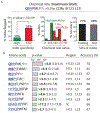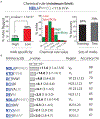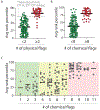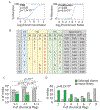Physicochemical Rules for Identifying Monoclonal Antibodies with Drug-like Specificity
- PMID: 32453957
- PMCID: PMC7936472
- DOI: 10.1021/acs.molpharmaceut.0c00257
Physicochemical Rules for Identifying Monoclonal Antibodies with Drug-like Specificity
Abstract
The ability of antibodies to recognize their target antigens with high specificity is fundamental to their natural function. Nevertheless, therapeutic antibodies display variable and difficult-to-predict levels of nonspecific and self-interactions that can lead to various drug development challenges, including antibody aggregation, abnormally high viscosity, and rapid antibody clearance. Here we report a method for predicting the overall specificity of antibodies in terms of their relative risk for displaying high levels of nonspecific or self-interactions at physiological conditions. We find that individual and combined sets of chemical rules that limit the maximum and minimum numbers of certain solvent-exposed amino acids in antibody variable regions are strong predictors of specificity for large panels of preclinical and clinical-stage antibodies. We also demonstrate how the chemical rules can be used to identify sites that mediate nonspecific interactions in suboptimal antibodies and guide the design of targeted sublibraries that yield variants with high antibody specificity. These findings can be readily used to improve the selection and engineering of antibodies with drug-like specificity.
Keywords: aggregation; developability; pharmacokinetics; polyspecificity; solubility; viscosity.
Conflict of interest statement
COMPETING FINANCIAL INTERESTS
None.
Figures








Similar articles
-
Toward Drug-Like Multispecific Antibodies by Design.Int J Mol Sci. 2020 Oct 12;21(20):7496. doi: 10.3390/ijms21207496. Int J Mol Sci. 2020. PMID: 33053650 Free PMC article. Review.
-
In vitro and in silico assessment of the developability of a designed monoclonal antibody library.MAbs. 2019 Feb/Mar;11(2):388-400. doi: 10.1080/19420862.2018.1556082. Epub 2019 Jan 18. MAbs. 2019. PMID: 30523762 Free PMC article.
-
Discovery-stage identification of drug-like antibodies using emerging experimental and computational methods.MAbs. 2021 Jan-Dec;13(1):1895540. doi: 10.1080/19420862.2021.1895540. MAbs. 2021. PMID: 34313532 Free PMC article. Review.
-
Mitigation of reversible self-association and viscosity in a human IgG1 monoclonal antibody by rational, structure-guided Fv engineering.MAbs. 2016 Jul;8(5):941-50. doi: 10.1080/19420862.2016.1171444. Epub 2016 Apr 6. MAbs. 2016. PMID: 27050875 Free PMC article.
-
Antibodies with Weakly Basic Isoelectric Points Minimize Trade-offs between Formulation and Physiological Colloidal Properties.Mol Pharm. 2022 Mar 7;19(3):775-787. doi: 10.1021/acs.molpharmaceut.1c00373. Epub 2022 Feb 2. Mol Pharm. 2022. PMID: 35108018 Free PMC article.
Cited by
-
Highly sensitive detection of antibody nonspecific interactions using flow cytometry.MAbs. 2021 Jan-Dec;13(1):1951426. doi: 10.1080/19420862.2021.1951426. MAbs. 2021. PMID: 34313552 Free PMC article.
-
Human antibody polyreactivity is governed primarily by the heavy-chain complementarity-determining regions.Cell Rep. 2024 Oct 22;43(10):114801. doi: 10.1016/j.celrep.2024.114801. Epub 2024 Oct 10. Cell Rep. 2024. PMID: 39392756 Free PMC article.
-
Developability considerations for bispecific and multispecific antibodies.MAbs. 2024 Jan-Dec;16(1):2394229. doi: 10.1080/19420862.2024.2394229. Epub 2024 Aug 27. MAbs. 2024. PMID: 39189686 Free PMC article. Review.
-
Quantitative flow cytometric selection of tau conformational nanobodies specific for pathological aggregates.Front Immunol. 2023 Aug 9;14:1164080. doi: 10.3389/fimmu.2023.1164080. eCollection 2023. Front Immunol. 2023. PMID: 37622125 Free PMC article.
-
Agonist antibody discovery: Experimental, computational, and rational engineering approaches.Drug Discov Today. 2022 Jan;27(1):31-48. doi: 10.1016/j.drudis.2021.09.008. Epub 2021 Sep 24. Drug Discov Today. 2022. PMID: 34571277 Free PMC article. Review.
References
-
- Wardemann H; Yurasov S; Schaefer A; Young JW; Meffre E; Nussenzweig MC Predominant autoantibody production by early human B cell precursors. Science 2003, 301, (5638), 1374–1377. - PubMed
-
- Maynard J; Georgiou G Antibody engineering. Annu Rev Biomed Eng 2000, 2, 339–76. - PubMed
-
- Perchiacca JM; Tessier PM Engineering aggregation-resistant antibodies. Annu Rev Chem Biomol Eng 2012, 3, 263–86. - PubMed
-
- Perchiacca JM; Ladiwala AR; Bhattacharya M; Tessier PM Aggregation-resistant domain antibodies engineered with charged mutations near the edges of the complementarity-determining regions. Protein Eng Des Sel 2012, 25, (10), 591–601. - PubMed
Publication types
MeSH terms
Substances
Grants and funding
LinkOut - more resources
Full Text Sources

